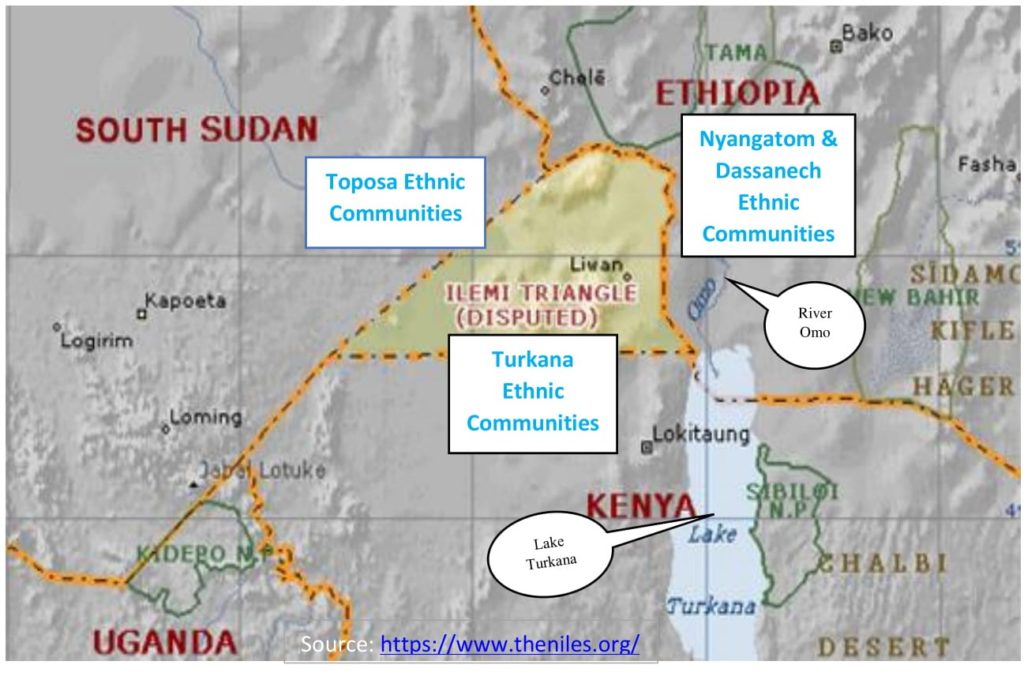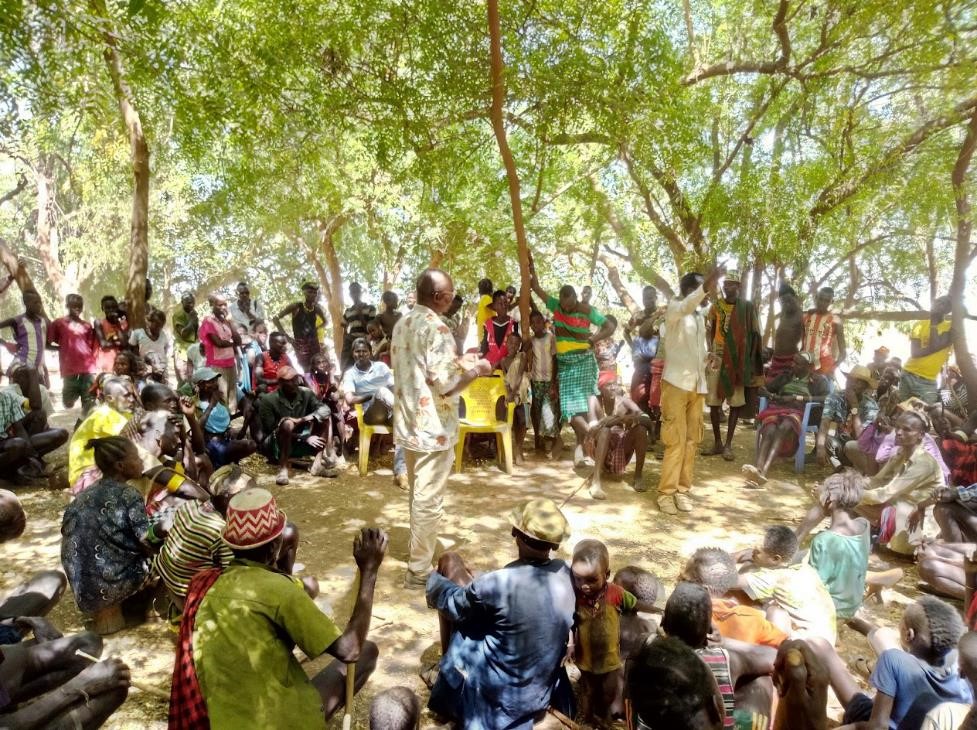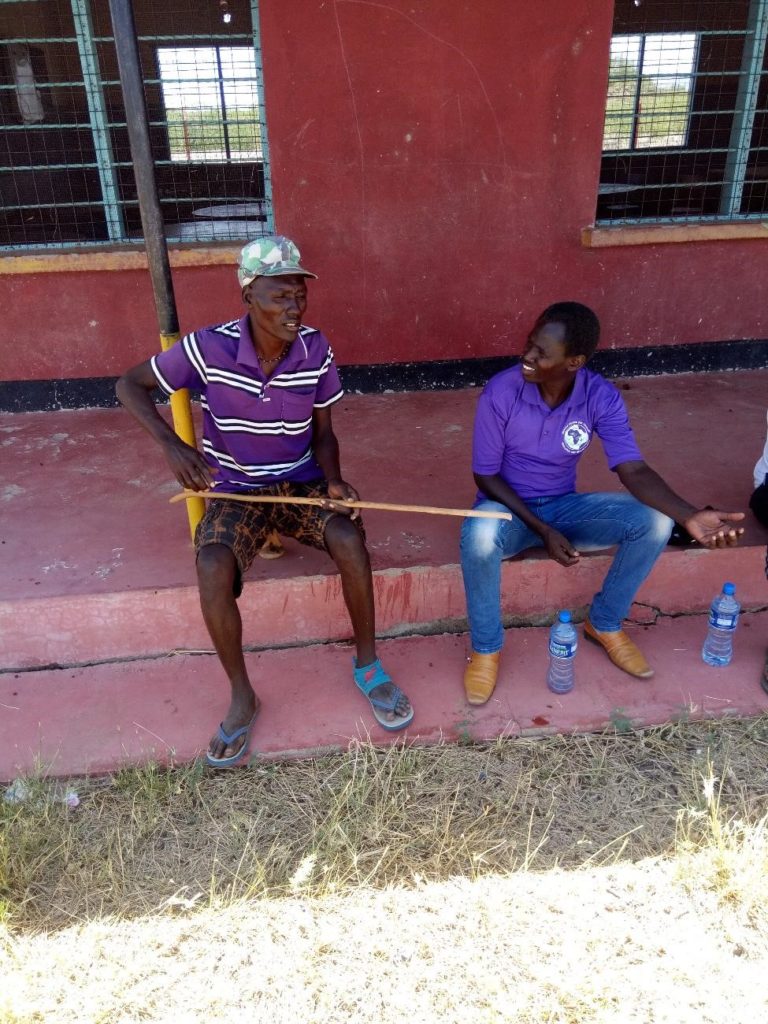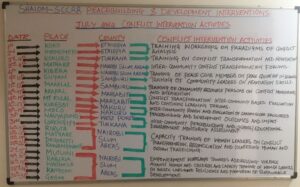The Ilemi region has been described as a ‘Triangle’ located where Kenya, South Sudan and Ethiopia interface with each other. Ilemi has been a bloody battlefield for ethnic communities living in and straddling the borders of the three countries in this area.[1] The inter-ethnic relationships of these communities have been affected by protracted conflicts which go back many years. Besides, there are century old contentious territorial claims about which country does the Ilemi Triangle belong to. The Ilemi Triangle measures over 14,000 square kilometers approximately [2](About the size of Northern Ireland). The conflict in the Ilemi has been frequently linked to issues of access to pasture and water. However, the causes and persistence of the conflict are much more variable and complex.

For communities living in the Ilemi Triangle, it is difficult to determine the extent to which international boundaries really matter for their daily lives; grass and water no matter where located takes precedence for both their survival and that of their livestock.
Communities living along the borders are Dassanech and Nyangatom in Ethiopia, Turkana in Kenya and Toposa in South Sudan. These communities have traditionally practiced nomadic pastoralism; moving across borders in search of basic human needs resources for themselves and their livestock.
Scarcity of grass and water triggered by climatic changes and increasing human and livestock population undoubtedly acts as catalysts for violent conflicts because competition sets in. Most conflicts turn out to be gruesome resulting in deaths, injuries and destruction of property and infrastructure.

In the month of February Shalom-SCCRR conducted conflict pre-assessment meetings with cross-border communities of Kenya and Ethiopia. These activities were informed by the emerging conflict issues and dynamics tracked over the past two years – years marked by relative calm. Communities which participated in the conflict pre-assessment were from Todonyang’, Kokuro and Kibish in Kenya, and Koro, Emomeri and Kang’ten in Ethiopia. The following are the conflict issues and dynamics established during the pre-assessment excercise:
- Increase in the number of sophisticated guns and other weaponry held illegally and used by cross-border communities;
- Frequent inter-communal violent conflicts with high number of deaths and injuries reported when compared to previous years;
- Frequent livestock raids resulting to massive loss of livestock leaving families with nothing for livelihood, and, triggering the cycle of revenge;
- Prolonged droughts affecting both livestock and human population;
- Conflict over fishing points in Lake Turkana between Turkana and Dassanech of Ethiopia;
- Reduced fish population and water volume in River Omo and Lake Turkana – which is seen as an effect of recently constructed Gilgel Gibe III Dam in Ethiopia. Ethnic communities living in Southern Ethiopia and North West Kenya have protested against construction of the dam because it interferes with their livelihoods as well as the ecology;
- Limited freedom of movement due to heightened tension and fear of attacks;
- Diminishing grazing areas and water points especially for Dassanech–affected by irrigation schemes established by the government of Ethiopia;
- Curtailment of mobility of the pastoralists as a way of keeping them away from emerging “private lands” and “farming schemes,” thus, forcing them to sedentarism with no alternative livelihoods which generates population issues in reduced space;
- Shrinking and low-quality grass fields as an effect of climate change and environmental degradation (reduced rain and increasing temperature);
- Increased poverty as a result of frequent raids, lack of stable settlements and prolonged droughts;
- Disregard for traditional mechanisms for conflict management and resolution;
- Growing feeling of structural exclusion from the state;
- A virtually total shift from traditional livestock raiding to banditry; executed by youth from the cross-border communities;
- Killing of women and children during raids who culturally were previously not targets.
The protraction of conflicts has seriously impacted on socio-economic status of the people. Notwithstanding all the hallmarks of marginalization obvious in the “Triangle,” the existing scant number of schools, hospitals and markets in the area has been adversely affected. Discussions with the people established a general feeling of despair and lack of alternatives to indicate hope and deliverance from this quagmire.

From the interviews with women, it was established that most of them had between 5–8 children. This a reflection of the population composition in terms of age categories. According to Turkana County statistics of two years ago, unemployment stood at 70%, most of the unemployed being youth. Similar situations are observable among pastoralist cross-border communities.
The extremely challenged communities of Ilemi triangle require a multi-faceted approach if any substantial socio-economic and even political change is to be realized. To intervene Shalom applies both peacebuilding and development approaches. Shalom has provided material help to schools like Todonyang’ Integrated Centre that supports inter-ethnic learning of Turkana and Dassanech from Southern Ethiopia. Shalom has also supported Napak and Koyasa primary Schools located along the Kenya-South Sudan border.
Through participatory research and conflict assessments, Shalom has established gaps in terms of skills to transform and resolve conflicts by the cross-border communities. Relevant skills are required to deal with conflicts that are globally driven and that have become complex with the availability of technology used negatively, and by the access to sophisticated weapons which are illegally acquired by civilians easily.
The second important point to note: most schools at the cross-border have not incorporated peace education in their programs. Peace education offers an opportunity to inculcate a culture of peace in students for present and future needs. Peace education in schools has positive impact at community levels also in terms of understanding the causes of conflict towards transforming relationships. These are lessons evidentially learned in Morijo and other Shalom projects intervention locations across Kenya’s Samburu County.
Even as the States surrounding the Ilemi Triangle work towards integrating their peace and security policies, there is a compelling need to continue building and strengthening capacities of individuals and communities in conflict prevention, management and transformation ultimately leading to settlement and resolution epitomized in reconciliation.
Shalom-SCCRR acknowledges also the value of local knowledge and traditional conflict management mechanisms. Therefore, Shalom’s approach is not just meant to build, but also to empower and strengthen capacities of individuals and communities.
Without help of the donors and friends these targets and goals cannot be realized to an optimum standard. Shalom appreciates their generous support because directly or indirectly they are protecting and saving lives and enabling better future for the people living in and around Ilemi Triangle through peacebuilding and education.
By Francis Mwangi, MA, BA. (Monitoring, Evaluation & Learning Coordinator, Shalom-SCCRR)
[1] Patrick. R. Devine. (2009). ”Turkana-Dassanech Conflict: Causes and Consequences.” Hekima University College (Catholic University of Eastern Africa). [2] Cf. Kenya National Archives, “Nairobi (hereafter KNA): DC/1SO/2/5/5 ‘The Kenya/Sudan boundary and the Ilemi Triangle” in Isiolo District Reports

